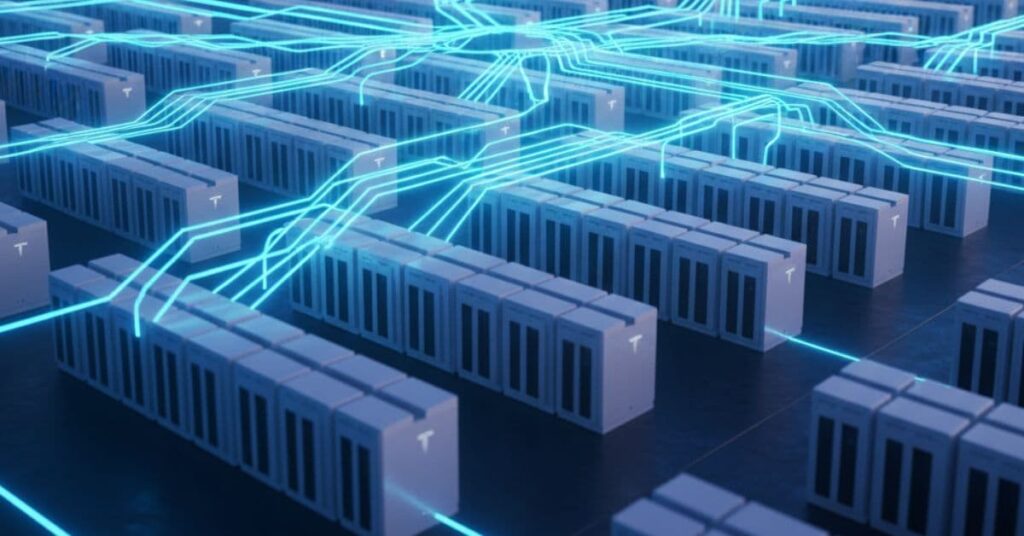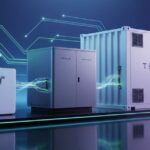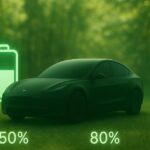The world needs to change to renewable energy, mostly solar and wind, for a better future. These energy sources have a big problem: they stop and start. The sun does not shine at night, and the wind does not blow all the time. This main challenge is that the power made does not always match the power people need. Advanced energy storage is the answer to this missing piece. Tesla Battery Storage Renewable Energy systems changed the game.
Tesla’s energy part, with its Powerwall, Powerpack, and Megapack, gives the needed technology to save energy when there is a lot of it. It then lets the energy out when people need it. By doing this, Tesla batteries do more than just hold energy. They make the electrical grid steady, take the place of power plants that use fossil fuels, and make the world change to a 100% sustainable energy economy faster. This is a big step. It turns power that stops and starts into clean energy that works all the time.
The article will look at the important job of Tesla Battery Storage Renewable Energy solutions. It will explain the problems they fix, the three main products they have, and the real difference they make in making the power grid modern.
Challenges In Renewable Energy
We must first understand the challenges of using a lot of renewable energy to understand why battery storage is important.
1. Intermittency Of Solar And Wind
Traditional power grids were built around “dispatchable” power sources. Power sources like coal and natural gas can be turned on or off to match the amount of power people need. Solar and wind are non-dispatchable power sources. Weather conditions control how much power solar and wind can produce.
- Solar: Production peaks around noon but drops to zero in the evening, precisely when residential energy demand peaks (the “duck curve” phenomenon).
- Wind: Production is often highest at night or in off-peak hours, when demand is low.
Without storage, the mismatch means the grid wastes good renewable energy. Or, the grid must use fossil fuel plants to make up the missing power. Relying on fossil fuels hurts the goal of a clean energy system.
2. Grid Instability and Frequency Regulation
The electrical grid runs at a specific rate called frequency (like 60 Hz in North America). A fast change in power coming in or power being used can make this frequency change. For example, this happens when a big cloud covers a solar farm or the wind suddenly slows down.
Old power plants help the grid stay steady with “inertia” and “frequency regulation.” When people add more solar and wind power that turns on and off, the grid becomes less stable. Tesla Battery Storage Renewable Energy systems, like the Megapack, are built to act very quickly. They give or take power instantly. This keeps the grid frequency steady. The service is faster and cleaner than using an old-style power generator.
Tesla Three-Tiered Battery Solution
Tesla has developed a comprehensive suite of battery products to address energy storage needs at every level, from the individual home to the utility grid.
| Tesla Battery Product | Scale of Deployment | Primary Function in Renewable Energy | Typical Use Case |
|---|---|---|---|
| Powerwall | Residential (Home) | Maximizing solar self-consumption and providing home backup power | Storing solar energy for night-time use; powering a home during a blackout |
| Powerpack | Commercial & Industrial (C&I) | Peak shaving, demand charge reduction, and microgrid formation | Storing energy for use during a business’s most expensive utility rate hours |
| Megapack | Utility-Scale (Grid) | Grid stabilization, frequency regulation, and replacing fossil fuel peaker plants | Storing massive amounts of solar/wind energy to be dispatched to cities |
1. Powerwall for Homes
The Powerwall acts as the base for Tesla’s battery storage for clean energy in homes. When people connect it with a solar system on their house, it helps them become very energy independent. The Powerwall keeps extra solar power that the system makes during the day. It lets the person use that clean power at night.
Furthermore, thousands of Powerwalls can also connect together to make a Virtual Power Plant (VPP). In a VPP, the power company can take small amounts of power from each home’s battery during a power crisis. This action creates a huge, spread-out power source that helps the whole town.
Powerwall Residential Benefits
- Home Energy Independence: Powerwall works with a solar system. It makes homes use the most energy they make themselves. Powerwall stores extra energy in the day. It lets people use the stored energy at night. It also gives backup power when the electricity goes out.
- Virtual Power Plant Integration: Powerwalls can connect to form VPPs. A VPP lets the utility take power from home batteries. Utilities take power during power emergencies. Taking power helps keep community energy reliable.

2. Powerpack for Businesses
The Powerpack works for businesses, schools, and factories. These customers often pay high “demand charges” to electric companies. Demand charges are extra fees for using the most electricity at one time. Businesses can save money by using the Powerpack to store energy.
The Powerpack then gives out the stored energy during those peak times. Powerpacks are also very important for microgrids. They let places far away or important buildings use only renewable energy and not need the main power grid.
Powerpack Commercial Benefits
- Reducing Demand Charges: Businesses can use Powerpack to store energy and discharge during peak usage hours, lowering expensive utility demand charges.
- Microgrid Support: Powerpacks support microgrid formation, allowing critical facilities or remote locations to operate independently on renewable energy.

3. Megapack for Utility-Scale
The Megapack is Tesla’s very large battery for power companies. It helps solve the problem when sun or wind power stops working at the biggest size. One Megapack can hold enough energy to give power to thousands of homes for several hours.
The primary function of the Megapack in Tesla Battery Storage Renewable Energy is to act as a massive energy buffer. It soaks up excess solar and wind power and releases it instantly when the grid needs it. This ability to “time-shift” renewable energy is what allows utilities to rely less on traditional, polluting power plants.
Megapack Utility Benefits
- Grid Stabilization: Megapacks provide large-scale energy storage to stabilize the grid, replacing fossil fuel peaker plants and maintaining reliable electricity supply.
- Time-Shifting Renewable Energy: They store excess solar or wind energy and release it when demand is high, enabling utilities to integrate renewable energy reliably.

The Role of Tesla Battery Storage in Grid Modernization
Tesla battery systems are basically changing how the electric grid works. They are moving the grid from one main power source that sends power one way to a smart grid that has many power sources and sends power two ways.
Time-Shifting Energy
Tesla Battery Storage allows utilities to store energy from one time of day for use at another, smoothing out the supply-demand mismatch.
Frequency and Voltage Regulation
Megapacks can react in milliseconds to correct grid frequency deviations and maintain voltage stability, managed by Tesla’s Autobidder software.
Case Study:
The Hornsdale Power Reserve in South Australia shows the most famous example of Tesla’s battery storage for clean energy. Workers built the project in 2017. The first project used a 100 MW/129 MWh Powerpack system. It was built to fix big problems with the power grid after a huge blackout.
The Challenge: South Australia used a lot of wind power. Wind power caused the electric grid to change often and cost a lot of money to manage.
The Solution: Workers put in the Tesla battery very fast. It took less than 100 days.
The Outcome: The battery worked very well. It fixed problems on the grid faster than any other power source. The battery saved the state millions of dollars by making the grid stable. It also made the power go out much less often.
Hornsdale’s success showed everyone that big battery storage works. It also showed that batteries are useful, make money, and are needed for a modern power grid. They have made the project even bigger since then, which proves it is valuable.
Practical Steps To Integrate Tesla Battery Storage
Whether you are a homeowner or a utility executive, integrating Tesla battery storage requires a strategic approach.
For Homeowners
If you are a homeowner, your focus should be on maximizing the value of your solar investment and securing your home against outages.
- Assess Your Needs: Determine your daily energy consumption. Find out which appliances must have power during an outage. Information will show the number of Powerwalls you need.
- Maximize Self-Consumption: Use the Tesla app to set the Powerwall to “Self-Powered” mode. Action makes sure you use your solar energy first. Using solar energy first makes your utility bill lower.
- Participate in VPPs: If a Virtual Power Plant program is in your area, join it. Program allows your Powerwall to earn money by helping the power grid when it needs it most.
For Utilities and Developers
For large-scale projects, the Megapack offers a streamlined solution.
- Simplicity of Deployment: Megapack is a product built and put together before it arrives. It makes setting up the system much easier and faster than building battery systems from scratch.
- Software Integration: The Megapack includes Tesla’s Autobidder software. An AI program runs Autobidder. The program handles the battery’s energy sales in the big market.
This makes sure the project earns the most money and helps the power grid the most.
Conclusion
Tesla Battery Storage Renewable Energy systems—Powerwall, Powerpack, and Megapack—are transforming how we use solar and wind power. They solve the intermittency problem, stabilize the grid, and enable 24/7 clean energy. From homes to utility-scale projects, Tesla batteries make renewable energy reliable, cost-effective, and a key part of a sustainable future.
FAQs
What is the difference between Powerwall and Megapack?
The main difference is size and use. The Powerwall is a small battery. It holds 13.5 kWh of power. People use it for their homes. The Megapack is a huge battery. It can hold up to 3.9 MWh of power in one unit. Power companies use it to make the electric grid steady and store power for whole cities. Both batteries use the same kind of lithium-ion technology, but people put them together and run them for different jobs.
How does Tesla battery storage help the environment?
Tesla Battery Storage Renewable Energy helps the environment in two main ways: first, by enabling more solar and wind power to be used, reducing the need for fossil fuel generation. Second, by replacing “peaker” plants—gas-fired power plants that only run during high-demand periods—which are typically the least efficient and most polluting generators on the grid.
What is a “peaker” plant, and how does Megapack replace it?
A peaker plant is a power station. It runs only when people need a lot of electricity. Peaker plants often do not work well and make a lot of air pollution. The Megapack stores energy. It can release energy fast to meet these high demands. Megapack does the same job as a peaker plant but makes no pollution. It is a cleaner and cheaper way to meet energy needs.
Is Tesla battery technology the same as in their cars?
The basic lithium-ion cell chemistry stays similar. However, the packaging and management systems are different. The Powerwall, Powerpack, and Megapack use battery parts made for storing energy in one place. These parts focus on lasting a long time and staying safe. They do not need the high power-to-weight ratio that electric cars need.







